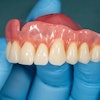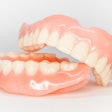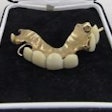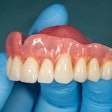
Postmenopausal women, particularly those with osteoporosis, are at greater risk for tooth loss compared with the general population, according to a new multinational study. However, the authors found that the prevalence of periodontitis was not influenced by osteoporosis in these women.
They noted that a couple of periodontal pathogens were detected in 100% of the patient samples, and others were found in almost all of the samples.
But "the presence of subgingival periodontopathogenic bacteria in almost all of our patients demonstrates that the appearance of these species is not sufficient to confirm the presence of periodontal disease," the authors wrote. "In fact, the mere presence of oral pathogens is recognized as being necessary but not sufficient for disease occurrence" (Journal of Periodontology, October 15, 2015).
Led by Scarlette Hernández-Vigueras, a doctoral student from the Autral University of Chile, the study authors did recommend a preventive oral health maintenance program to minimize any effects of bone loss on periodontal tissues.
Periodontitis and oral variables
As population data show both a graying population and that women generally live longer than men, the need to help menopausal and postmenopausal women maintain their oral health is clear. This study, from researchers in Chile and Spain, attempted to detect and quantify the main periodontal pathogens in the oral microbiota of postmenopausal women. This in turn would help researchers "explore the relationship between the microbiota and clinical and periodontal parameters."
This was an observational cross-sectional study of 76 postmenopausal women from Barcelona, Spain. All of the participants received a complete oral examination between May 2009 and September 2012, and the following variables were assessed:
- Number of missing teeth, not including third molars
- Pocket depth
- Oral hygiene status, determined according to the criteria of the index of Greene and Vermillion
- Carious, absent, and obturated teeth (CAOD) index
- Mucosal injury
- Periodontal treatment needs
- Oral pH
- Xerostomia
The researchers found that Tannerella forsythia and Campylobacter rectus were detected in 100% of the samples, Fusobacterium nucleatum and Porphyromonas gingivalis were found in 98.7% of the samples, and Aggregatibacter actinomycetemcomitans in 73.7% of the samples.
Almost 23% of the women with no previous diagnosis of osteopenia/osteoporosis had periodontitis, compared with 57.1% of the women with osteopenia and 20% of those with osteoporosis. The authors noted there was no association between osteoporosis/osteopenia and periodontitis (p = 0.522) (see table).
They reported a significant correlation between periodontitis and oral hygiene (p = 0.003) and between periodontitis and the need for treatment (p = 0.001). But there was no significance in the associations between periodontitis and missing teeth and between periodontitis and xerostomia (p = 0.120 and p = 0.098, respectively).
| Correlation between periodontitis and clinical and oral variables | ||||
| Variable | Periodontitis | Total | P-value | |
| Negative (n = 38) |
Positive (n = 35) |
|||
| Osteoporosis | 0.522 | |||
| No | 8 | 8 | 16 | |
| Osteopenia | 18 | 20 | 38 | |
| Osteoporosis | 12 | 7 | 19 | |
| Age | 0.418 | |||
| 60 or younger | 2 | 4 | 6 | |
| Older than 60 | 36 | 31 | 67 | |
| pH | 0.546 | |||
| Basic | 7 | 7 | 14 | |
| Neutral | 12 | 14 | 26 | |
| Acid | 17 | 11 | 28 | |
| CAOD (mean) | 16.53 | 17.94 | 17.21 | 0.454 |
| Treatment need | 0.001 | |||
| None | 4 | 1 | 5 | |
| Profound hygiene | 26 | 12 | 38 | |
| Periodontal | 8 | 22 | 30 | |
| Oral hygiene | 0.003 | |||
| Good | 19 | 5 | 24 | |
| Regular | 14 | 18 | 32 | |
| Bad | 5 | 12 | 17 | |
| Xerostomia | 0.098 | |||
| No | 37 | 30 | 67 | |
| Yes | 1 | 5 | 6 | |
| Mucosal injury | 0.215 | |||
| No | 26 | 19 | 45 | |
| Yes | 12 | 16 | 28 | |
Different results
Previous studies have reported that periodontal disease is a strong and independent predictor of tooth loss in postmenopausal women, which was not established in this study.
The authors suggest that patients with chronic periodontitis "undergoing therapy may have lower rates of tooth loss." They use the example of a patient taking systemic statins for lipid-lowering therapy. These statins, according to the study authors, have an anti-inflammatory effect on periodontal disease and protect against tooth loss.
While osteoporosis did not influence the prevalence of periodontitis among postmenopausal women, preventive maintenance was needed, they noted.
"A preventive maintenance program for postmenopausal women, particularly osteoporotic women, who are at greater risk of tooth loss, could minimize the potential effects of bone loss on periodontal tissues," the authors concluded.



















